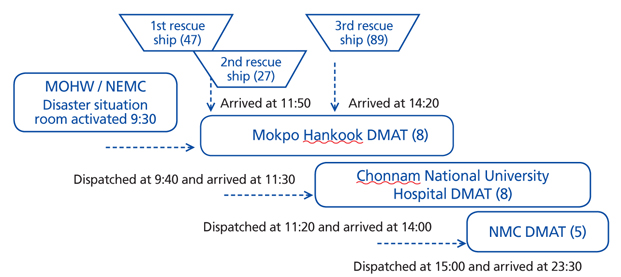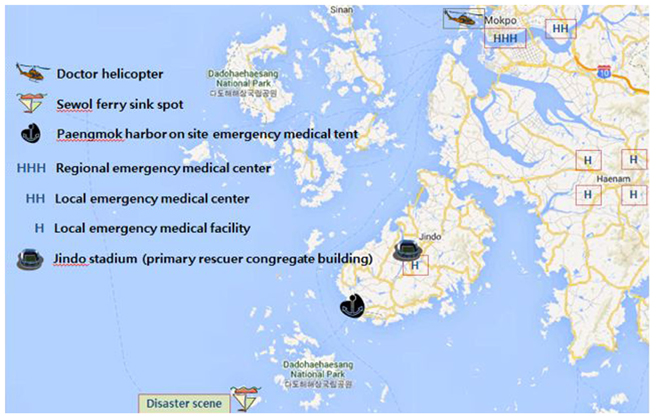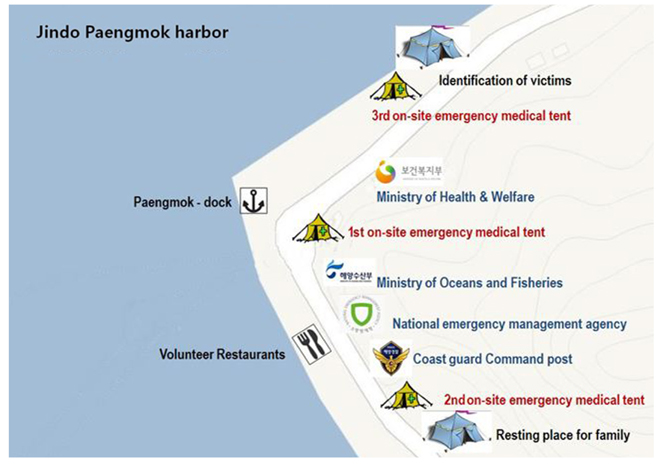J Korean Med Assoc.
2014 Dec;57(12):999-1007. 10.5124/jkma.2014.57.12.999.
Experiences and lessons of the disaster medical assistance in Korea
- Affiliations
-
- 1National Emergency Medical Center, Seoul, Korea.
- 2Department of Emergency Medicine, Myongji Hospital, Seoul, Korea.
- 3Department of Emergency Medicine, Hallym University College of Medicine, Seoul, Korea. erwsj@chol.com
- KMID: 1736628
- DOI: http://doi.org/10.5124/jkma.2014.57.12.999
Abstract
- In the cases of two important disasters that occurred in Korea in 2014, it was important to spread information early and to respond systematically for rapid utilization of disaster medical resources. Initial response units such as fire and police departments should deliver disaster medical information to disaster medical units and systems to facilitate the rapid response of disaster medical resources. When considering disaster medical situations in Korea, the size of a disaster medical assistance team should be smaller compared to the United States for an effective domestic disaster medical response. In addition, regional disaster manuals or guidelines should be accepted in place of instructions from the central government for detailed disaster medical response in each disaster region, and repeated disaster drills that include related organizations should be performed. The provision of institutional strategy is needed to support the basis of on-site disaster medical assistance activities and the existence of disaster medical assistance team.
Keyword
Figure
Cited by 2 articles
-
Emergency Medicine in Disasters
Soon-Joo Wang
Hanyang Med Rev. 2015;35(3):124-130. doi: 10.7599/hmr.2015.35.3.124.Disaster medical response system in Korea
Jungeon Kim, Hyun Soo Chung
J Korean Med Assoc. 2019;62(5):252-257. doi: 10.5124/jkma.2019.62.5.252.
Reference
-
1. Koenig KL, Schultz CH. Koenig and Schultz's disaster medicine: comprehensive principles and practices. New York: Cambridge University Press;2009.2. Adams J. Emergency medicine: clinical essentials. 2nd ed. Philadelphia: Saunders;2013.3. Timm N, Reeves S. A mass casualty incident involving children and chemical decontamination. Disaster Manag Response. 2007; 5:49–55.
Article4. Kennedy PJ, Haertsch PA, Maitz PK. The Bali burn disaster: implications and lessons learned. J Burn Care Rehabil. 2005; 26:125–131.
Article5. You KC, Ahn ME, Cho YJ, Chaeng JM, Lim KS. Injury type in Sampung collapse. J Korean Soc Emerg Med. 1997; 8:185–192.6. Kang YJ, Kim WJ, Park JO. Characteristics of injured patients related with typhoon Nari. J Korean Soc Emerg Med. 2008; 19:462–473.7. Lee KW. Clinical analysis of the stadium stampede in Sang-ju, Korea. J Korean Soc Emerg Med. 2007; 18:367–374.8. Kim YJ, Park NH, Lee JS, Ryoo HW, Park JB, Seo KS, Chung JM. An analysis of disaster recognition in medical personnel and 119 rescuers after Daegu subway disaster. J Korean Soc Emerg Med. 2006; 17:395–405.9. Jacobs LM Jr, Goody MM, Sinclair A. The role of a trauma center in disaster management. J Trauma. 1983; 23:697–701.
Article10. Baek KJ, Hong YS. Current status of korean disaster medicine: analysis of railroad collapsed accident of Gupo. J Korean Soc Emerg Med. 1993; 4:40–46.11. Ammons MA, Moore EE, Pons PT, Moore FA, McCroskey BL, Cleveland HC. The role of a regional trauma system in the management of a mass disaster: an analysis of the Keystone, Colorado, chairlift accident. J Trauma. 1988; 28:1468–1471.
Article12. Smith JS Jr, Fisher JH. Three mile island. The silent disaster. JAMA. 1981; 245:1656–1659.
Article13. Mace SE, Jones JT, Bern AI. An analysis of Disaster Medical Assistance Team (DMAT) deployments in the United States. Prehosp Emerg Care. 2007; 11:30–35.
Article14. Ko HJ, Lee KH, Kim OH, Cha YS, Cha KC, Kim H, Hwang SO, Ahn ME, Cho JW. Experiences of a disaster medical assistant team in the Chun-cheon landslide disaster. J Korean Soc Emerg Med. 2013; 24:493–499.15. Chung JM, Seol DH, Park JB, Seo KS, Lee JH, Kim HD, Kim JK, Lee DP, Lee SB, Do BS, Wang SJ, Ahn MU. Analysis of transportation of victims of the subway fire in Daegu. J Korean Soc Emerg Med. 2003; 14:514–521.16. Fuse A, Yokota H. An analysis of Japan Disaster Medical Assistance Team (J-DMAT) deployments in comparison with those of J-DMAT's counterpart in the United States (US-DMAT). J Nippon Med Sch. 2010; 77:318–324.
Article17. No. 12844. Emergency Medical Service Act of 2012. 2008. 12. 31.18. Holloway RM. Medical disaster planning. II. New York City's preparations. N Y State J Med. 1971; 71:692–694.19. Holloway RM. Medical disaster planning. I. Urban areas. N Y State J Med. 1971; 71:591–595.
- Full Text Links
- Actions
-
Cited
- CITED
-
- Close
- Share
- Similar articles
-
- Experiences of disaster medical assistance activities in a fire accident at the Ramada Encore Hotel, Cheonan
- Experience of a Medical Assistance for Disaster Caused by a Typhoon of Haiyan in the Philippines
- Disaster Medical Assistance Team
- Principles and system of disaster medicine
- Hospital disaster plan and disaster medicine




